Introduction
'Horvin' plum fruits have great acceptance in markets because they have excellent organoleptic and nutritional characteristics. Because it is a climacteric fruit, it can be harvested at physiological maturity, given that maturation continues during the postharvest period (Parra, Hernández, and Camacho, 2008). There are currently very little studies that have determined the optimum harvest maturity of 'Horvin' plums. In most cases, these determinations have been carried out subjectively, based only on the size and peel color of the fruits, resulting in inconsistent organoleptic characteristics when marketing the product (Kaur, Sawhney, and Jawandha, 2018). This is the cause for the negative perception of the cultivar in a market with high demands and requirements regarding fruit quality (Kader, 2008).
The ripening process in plums is closely related to quality because it involves a series of biochemical, physiological, and structural changes that make the fruits more attractive for consumers (Rozo-Romero, /Alvarez-Herrera, and Balaguera López, 2015). These processes involve an increased production of ethylene and the permeability of cell membranes, as well as chemical transformations that affect phenolic compounds, organic acids, pigments, and pectins, which modify the organoleptic characteristics of the fruits (Saltveit, 2019).
Minas, Crisosto, Holcroft, Vasilakakis, and Crisosto (2013) reported that the postharvest shelf-life of plums is very short and hardly exceeds seven days in the absence of management, given its moderate respiratory rate (10 to 20 mgCO2-kg-1 -h-1) and high production of ethylene, which accelerates the metabolic processes that affect maturation (Kader, 2002). Therefore, it is necessary to maintain an optimal temperature during the postharvest period, which delays ripening and preserves quality because the respiration rate increases with temperature, thus leading to the acceleration of ripening and senescence in fruits (Iqbal, Rodríguez, Mahajan, and Kery, 2009).
Similarly, the maturity stage of collected fruits has a great influence on their postharvest storage duration and marketing because fruits undergo internal and external changes triggered by the release of ethylene (Larsen and Vangdal, 2013). These changes are physical, chemical, and physiological, such as loss of mass and firmness and flesh softening, which expose the external structures to environmental conditions. A reduction also occurs in the contents of starch and organic acids, along with an increase in the contents of sugars (Saltveit, 2019).
In this regard, /Alvarez Herrera et al. (2015) stated that the market conditions of 'Horvin' plums and fresh consumption define the degree of maturation (color) at the time of harvest because the eating quality of the fruit depends on the degree of maturation at this point. The greater the degree of maturation, the shorter the shelf-life, thus resulting in the need for refrigeration to maintain quality in the postharvest period (Guerra and Casquero, 2008).
Therefore, the objective of this study was to evaluate the effect of harvest maturity (states 2, 3, 4, and 5) and storage temperature (2, 4, and 18 °C) on the organoleptic and physicochemical quality of 'Horvin' plums (Prunus domestica L.).
Materials and Methods
Location: This study was carried out in the plant physiology laboratory of the Universidad Pedagógica y Tecnológica de Colombia (Boyacá, Colombia), Tunja branch. The fruits were collected from a commercial crop in the municipality of Tuta, located at an altitude of 2600 masl, 05° 41 '36" north latitude and 73° 13' 51" west longitude, with an average rainfall of 935 mm and a temperature ranging between 12 and 14 °C, as well as an average relative humidity of 70%.
Ecotype: 'Horvin' plums (Prunus domestica L.) were used. The fruits were collected at four maturity stages (2, 3, 4, and 5) according to their color (Alvarez-Herrera, Rozo-Romero, and Reyes, 2015). Fruits of uniform size, free of mechanical damage, and in good phytosanitary conditions were chosen. Two cold refrigerators with controlled temperatures and relative humidity (SuperNordico, 9, and 12 cubic feet) were used for the storage. Temperature in the refrigerators was verified with a thermometer during the experiment.
Experimental Design: a completely randomized design with a 4 x 3 factorial arrangement was used. The first factor corresponded to the stage of maturity (2: 75% green - 25% red; 3: 50% green - 50% red; 4: 25% green - 75% red; and 5: 100% red), and the second factor to the refrigeration temperatures (2 °C, 4 °C, and ambient 18 °C). Hence, a total of 12 treatments, each with 4 replications corresponding to 48 experimental units. Each unit had 900 g of fruits (45 fruits of 18 g, approximately), which were disinfected with a solution of 1% sodium hypochlorite after harvest. Then, they were air-dried for 30 minutes and packed in two Styrofoam containers with a capacity of up to 450 g of fruit for each experimental unit.
Response variables: Every three or four days, mass loss, color, and respiratory intensity, firmness, pH, total titratable acidity, and total soluble solids were measured. The measurements were taken until the fruits their lost organoleptic quality.
Mass loss was determined by measuring the fresh mass with a 0,01g precision electronic scale, an Acculab VIC 612 (Sartorius Group, Germany). Fruit firmness was measured with a PCE-PTR200 (PCE-Iberica, Spain) digital penetrometer, with an accuracy of 0,05 N. Peel color was determined with a CR 300 Minolta digital colorimeter (Minolta Co., Japan) according to the CIELab system parameters L*, a*, and b*. Three readings were taken on the equatorial axis of two fruits per evaluation date at the same point. L* indicates lightness, where 0 is black and 100 white; a* values <0 indicate a trend towards green and values > 0 indicate red; b* has the same range, but values < 0 indicate a tendency towards blue, and values > 0 towards yellow (Pathare et al., 2013). The color index (CI) was calculated with Equation 1.
To determine the pH, approximately 1 mL of juice was diluted to 50 mL with distilled water, and the pH was measured with a HANNA HI8424 potentiometer (Hanna Instruments, Spain), previously calibrated with buffer solutions of pH 7,0 and 4,0. In a juice sample extracted from three fruits of each EU, the total soluble solids (TSS) were measured in degrees Brix with a HANNA HI 96803 digital refractometer (Hanna Instruments, Spain), with a range of 0-85% and 0,1 °Brix accuracy. The total titratable acidity (TTA) was determined following the methodology used by Rozo-Romero et al. (2015). The maturity index (MI) was expressed as the TSS/TTA ratio.
Additonally, the respiratory rate was determined (RR; pL CO2 kg-1 h-1) by placing approximately 200 g of plum fruits in 250 cm3 SEE BC-2000 airtight chambers for 1 hour. Subsequently, C02 evolution was determined with a VER C02-BTA sensor and a LabQuest2 interface system (Vernier Software and Technology, United States).
Data analysis: A Shapiro-Wilk normality test was carried out on the data, followed by an analysis of variance. Atypical and outlier values were removed from the data set. The Tukey comparison test (p ≤ 0,05) was used to determine statistical differences between treatments in order to classify them. The analyses were performed using the statistical software SAS v. 9,2e (SAS Institute Inc., Cary, NC).
Results and Discussion
Loss of mass: significant differences were only observed towards the end of the storage period, at 28 and 31 days after harvest (dah) (Figure 1a). Maturity state 5 had the highest loss of mass after 10 dah, and reached 36,8%, compared to the other maturity stages, which, at the end of the postharvest period, had loss of mass ranging from 28,1% to 30,1%. The loss of mass increased almost linearly throughout the postharvest period, and fruits harvested in the earliest maturity stage had the lowest rates, similar to those found by Guerra and Casquero (2008). However, they obtained lower values of mass loss (12%) due to the fact that all the fruits were refrigerated.
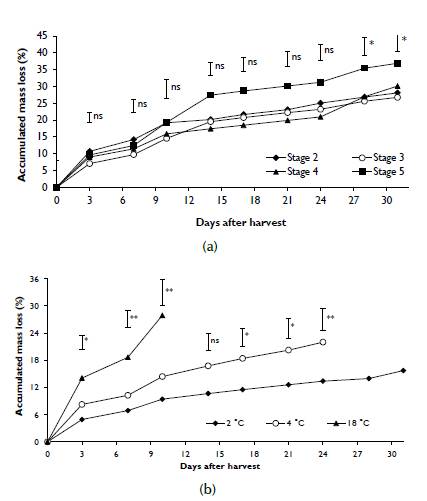
Note: The vertical bars indicate the minimum significant difference according to the Tukey test (p ≤ 0,05). *statistical differences at 5%, **statistical difference at 1%, ns: no differences. Source: Authors
Figure 1 Effect of a) the maturity stage and b) storage temperatures on the accumulated loss of mass of plum fruits during postharvest cold-storage.
As for the storage temperature, significant differences were seen between the fruits stored at 18 °C, with a mass loss of 27,9% at 10 dah, and those with 9,4% and 14,3% when stored at 2 and 4 °C, respectively (Figure 1b), which means that the loss of mass in the fruits stored at high temperatures resulted from the fruits' regulating the temperature through water evaporation, leading to severe dehydration and deterioration in their external appearance, thereby reducing their commercial value (Minas et al., 2013). In this regard, Parra et al. (2008) reported mass loss values of 23% in Horvin plums stored at 18 °C at 11 dah, while the fruits subjected to 4 °C obtained a cumulative mass loss of 3,2% at 31 dah. Nevertheless, the evaluated plums stored at 4 °C only reached 24 days, where their mass loss was higher, probably due to the low relative humidity, causing the fruits to dehydrate and lose their commercial quality.
Mass loss was greater as the storage temperature increased, probably due to the increase in the vapor pressure deficit (VPD), which caused greater moisture loss (Diaz-Perez, 2019). When the fruits were refrigerated, they maintained a very low loss of mass rate, with reductions of 15% and 12% for 'President' and 'Royal Rosa' plums, respectively (Martinez-Romero et al., 2019). Likewise, the respiration process was not inhibited, and the low relative humidity directed the exchange of water from the fruits to the environment (Palou, Crisosto, Garner, and Basinal, 2003), which coincides with Larsen and Vangdal (2013), who reported a decrease in the respiration rate of 9 plum cultivars stored at 2 °C and, consequently, a loss of mass lower than that of fruits stored Firmness: for the maturity factor, it was observed that, as the storage time elapsed, the fruits of all the treatments showed loss of firmness, possibly due to the action of hydrolase enzymes, which are induced by ethylene (Botton, Tonutti, and Ruperti, 2019). This occurs naturally in climacteric fruits such as 'Horvin' plums. These enzymes, such as polygalacturonase (PG), pectinmethylesterase (PME), β-galactosidase, and pectatelyase (PL), degrade the polymeric carbon hydrates, mainly pectin and hemicellulose (Sanudo-Barajas et al., 2019), thus weakening of cell walls. In all maturity stages, the firmness decreased considerably until 14 dah, and, from this day, the loss of firmness was slower, (Figure 2a), which is probably due to the intensive loss of water in the cells of the fruit during the first days of storage. The fruits that maintained the firmness for the longest time were those stored in maturity state 2, while the loss of firmness was highest in maturity stage 5 because, during the postharvest period, the production of ethylene is greater, as it accelerates the maturation and senescence process.
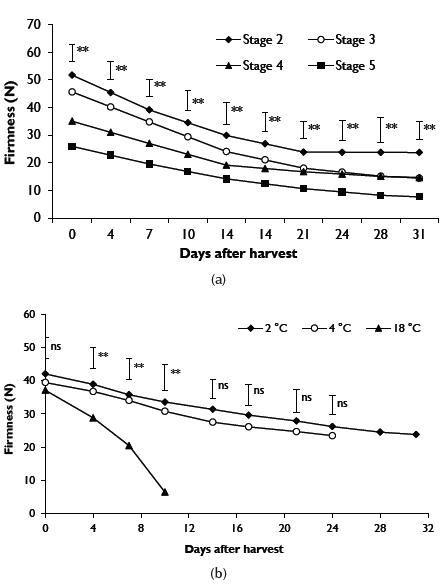
Note: The vertical bars indicate the minimum significant difference according to the Tukey test (p ≤ 0,05). *statistical differences at 5%, **statistical difference at 1%, ns: no differences. Source: Authors
Figure 2 Effect of a) the maturity stage and b) storage temperatures on the firmness of plum fruits during postharvest.
As for the effect of the temperature on fruit firmness, significant differences were observed between the fruits stored at 18 °C and the refrigerated fruits (2 and 4 °C) from 7 dah, with an average value of 20,46 N for the first, as compared to higher data for the refrigerated fruits (35,79 N at as 6,46 N for the fruits stored at 18 °C. These results agree with those reported by Parra et al. (2008) for 'Horvin' plums stored at 18 °C, where firmness decreased drastically during the postharvest period. Likewise, Wang, Pan, Wang, Hong, and Cao (2016) found that plum fruits stored at 0 and 2 °C managed to maintain firmness for a longer time, while fruits stored at higher temperatures showed a drastic softening. Skin color: color showed significant differences in almost all sampling points with respect to the stage of maturity, since it was the parameter by which the fruits were classified. Therefore, maturity stage 2 plums demonstrated the highest lightness values, with the lowest value in maturity stage 5 at all sampling points (Table 1). This happens because, as fruits ripen, they lose lightness due to the oxidation process of tissues and water loss (Singh, Singh, and Swinny, 2012). As for the a* values, stage 4 had the highest (28,3) 28 days after harvesting, compared to stage 2, where a value of -17,29 was obtained, indicating that the color change from green to red was more noticeable in stage 4 than in the other stages, which probably occurred because, during the ripening of fruits, chloroplasts and thylakoid membranes disintegrate, a process that generates a rapid loss of chlorophyll and green color in plum tissues, which is increased by temperature (Wu et al., 2011), thus resulting in the synthesis of red pigments or anthocyanins in the plums. This change occurs in greater proportion in fruits in advanced stages of maturity because it takes longer for physiological changes to occur, such as degradation of chlorophylls and the unmasking of pigments.
Table 1 Effect of maturity stage and storage temperature on skin color of 'Horvin' plum fruits
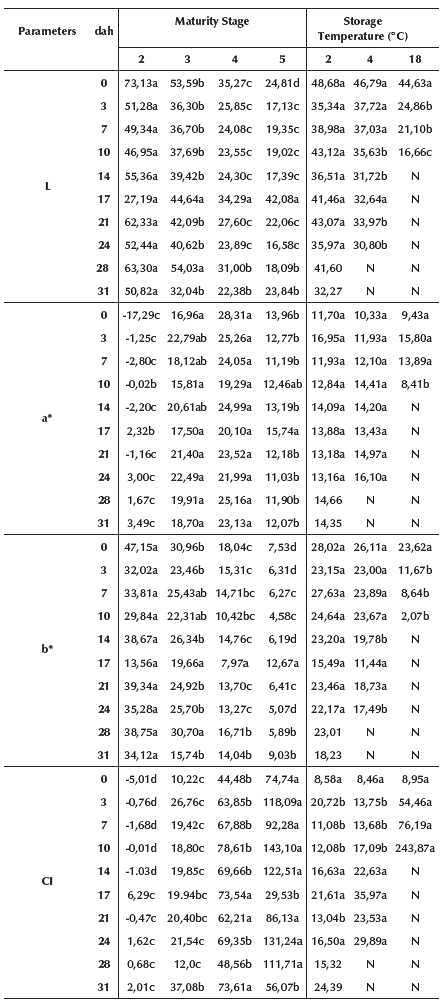
Note: dah: days after harvest; L: Lightness; a*: range from green to red; b*: range from blue to yellow; CI: color index; pH: potential hydrogen; TTA: Total titratable acidity; TSS: Total solids soluble; MI: Maturity index. N: no data for the loss of organoleptic quality. Means with different letters in the same row and classified by factor indicate significant differences between the factor levels according to the Tukey mean test (p ≤ 0,05).
Source: Authors
As for the temperature factor, there were significant differences in most of the sampling points for the lightness of the plum fruits (Table 1), which showed higher values in the fruits stored at 2 °C. In plums, the most representative value for the coloring of the epidermis is the a* value, for which there were no significant differences in most of the sampling points. A significant difference was only observed at 10 dah between the fruits stored at room temperature (which had lost commercial quality at this time) and the refrigerated fruits, demonstrating that refrigerated storage delays the color change from green to red, although there was no difference between the two refrigeration temperatures, according to Xu et al. (2020), who state that treatments with low temperatures reported the highest values of anthocyanins. In addition, refrigeration delays the respiratory process and, therefore, the production of ethylene, which in turn produces changes in pH and thus promotes the action ofchlorophyllases (Singh and Singh, 2013).
In general, the color index was higher in stage 5 (100% red) and in the fruits stored at ambient temperature (Table 1), although only significant differences were obtained in the refrigerated fruits after 24 dah with CI values of 29,9 and 16,5, for 4 and 2 °C treatments, respectively. Then the 4 °C treatment lost commercial quality, indicating that, after 24 days, the color index becomes similar and independent of the storage temperature, according to what was reported by Pan et al. (2016) in three plum varieties subjected to ethylene applications under storage conditions. These data show the typical tendency of ripening fruit because, as the storage time progresses, degreening occurs, which, in some fruits, is related to the degradation of chlorophyll during maturation (Hussain, Suradkar, Wani, and Dar, 2015).
pH: the highest values were obtained in plum fruits harvested at maturity stage 5, with significant differences throughout the entire storage (Table 2), contrary to what was found by Alvarez-Herrera et al. (2015) in plum fruits treated with ethylene, where the different maturity stages had similar pH values. This implies that the maturity state in which the fruits are harvested is important for their organoleptic properties, even during the postharvest life of the fruits.
Table 2 Effect of maturity stage and storage temperature on physical variables measured in 'Horvin' plum fruits
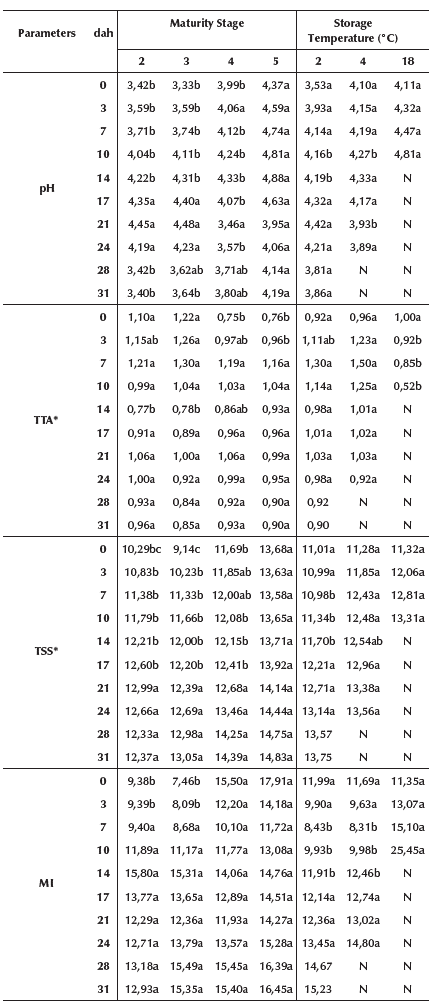
Note: dah: days after harvest; L: Lightness; a*: range from green to red; b*: range from blue to yellow; CI: color index; pH: potential hydrogen; TTA: Total titratable acidity; TSS: Total solids soluble; MI: Maturity index. N: no data for the loss of organoleptic quality. Means with different letters in the same row and classified by factor indicate significant differences between the factor levels according to the Tukey mean test (p ≤ 0,05).
Source: Authors
As for the temperature factor, a pH of 4,81 was observed at 10 dah in the fruits stored at 18 °C, as compared with values of 4,16 and 4,27 obtained in fruits stored at 2 and 4 °C, respectively, indicating that the fruits had higher pH when stored at ambient temperature (Table 2), in comparison with their refrigerated counterparts.
In this regard, it is known that, as fruits ripen, acids function as respiratory substrates (Saltveit, 2019). Therefore, pH changes match the variations in the coloration of the fruits, considering that hydrogen ions contribute to the degradation of chlorophyllases of plum fruits. The pH values showed an average correlation for the different treatments of 0,57, 0,55, 0,37 and 0,37 with the variables b*, L*, a*, and CI, respectively. Furthermore, the state of ripeness of the fruits changed, with a consequent increase in pH that promoted the action of chlorophyllase, which generally contributes to the degradation of the chlorophyll (Koca, Karadeniz, and Burdurlu, 2007).
Total titratable acidity (TTA): a normal tendency was observed in the fruits at different stages of maturity, as shown in Table 2. Although the differences were not always statistically significant, the acidity was generally lower in the fruits harvested at maturity stage 5 (0,95%) than in the other states, as observed in all of the measuring points. The higher TTA average values were generally seen in maturity stages 2, 3, and 4 (1,00%, 1,01% and 0,96%, respectively), which may indicate that fruits that have lower maturity and a higher amount of organic acids for use as respiratory substrates have a better postharvest behavior and, therefore, a longer shelf-life (Batista-Silva et al., 2018).
Highly significant differences were seen at all the sampling points from 3 dah for the temperature factor (Table 2), and there were no significant differences between the treatments with refrigeration at 2 and 4 °C. The TTA values ranged between 1,03% and 1,12% in fruits stored at 2 and 4 °C, respectively, which were higher than the average value obtained for the fruits stored at room temperature (0,80%), which confirmed the reduction in the metabolic processes due to the cooling effect (Larrigaudiere, Candan, Ubach, and Graell, 2009).
As for the interaction between the temperature and stage of maturity, significant differences were only observed during the first 10 dah, since the less mature fruits have more TTA, as well as the aforementioned cooling effect, to maintain the pH in plum fruits. The TTA remained constant in the refrigerated fruits, whereas, in the fruits stored at 18 °C, it decreased by 48% during their postharvest life, which is due to the fact that organic acids present in the cells are degraded by the synthesis of other substances and the oxidation in the respiratory metabolism, a reaction that results in an increase in the respiratory rate (Saltveit, 2019). In this regard, Parra et al. (2008) found TTA decreases in plums stored at 4, 12, and 18 ° C, showing differences between the refrigerated fruits and those stored at room temperature.
Total soluble solids (TSS): there were significant differences between the stages of maturity at all sampling points up to 17 dah (Table 2). The highest values were obtained in the fruits harvested at maturity stage 5 (14,03 °Brix), which matches the data reported by Ndou, Tinyani, Slabbert, and Sultanbawa (2019), who stated that fruits harvested in later stages of maturation have a higher TSS concentration than those collected in the early stages.
Regarding the temperature factor, there were significant differences between the fruits stored at 2 °C and the fruits stored at 4 and 18 °C from 7 to 14 dah. From 17 dah on, the refrigerated fruits did not show differences between temperatures of 2 and 4 °C. This behavior indicates that the TSS of the fruits remained constant for longer at a storage temperature of 2 °C. However, at the end of the postharvest period, these values increased slightly, similar to those found by Singh and Singh (2013) with plum fruits stored at 0 °C and a TSS increase only occurring on the fourth postharvest week. This increase in sugars was a product of the hydrolysis of starch and the synthesis of sucrose and gluconeogenesis (Farcuh, Rivero, Sadka, and Blumwald, 2018).
The results of this study are consistent with those reported by Parra et al. (2008), where the TSS values of plums stored at 4, 12, and 18 °C did not vary significantly throughout the storage period. There were no significant differences between treatments, which was attributed to the effect of the temperature, which decreases the speed of change in fruits, thus affecting the accumulation of sugars (Hussain et al., 2015).
Maturity Index (MI): this variable showed significant differences for the maturity stages at the first two sampling points (Table 2). In general, the highest values were observed in the fruits at maturity stage 5, with an average of 14,20, while stages 2, 3, and 4 presented an average MI of 11,6, 12,04, and 13,95, respectively. This occurred because the fruits harvested in an immature state took longer to reach consumption maturity than those harvested closer to the optimum harvest point (Ndou et al., 2019). The MI increased as the storage time passed in the fruits harvested in stages 2 and 3, while, in the stages 3 and 4, the MI remained constant during their postharvest life. This decrease in stages 2 and 3 was caused by the reduction in TTA during storage.
The effect of the storage temperature showed a similar trend, in which there were significant differences between 7 and 14 dah. We could observe differences between the fruits stored at 18 °C (14,85) and the fruits refrigerated at 2 (12,07) and 4 °C (12,13), where the values were much lower (Table 2). These results agree with those reported by Parra et al. (2008) for 'Horvin' plums, where the smallest increase in the MI was in a treatment at 4 ° C, which supports the study by Kader (2008), who claimed that the reduction in temperature decreased the effect of ethylene on fruit ripening, like respiration, which therefore slows the process.
The fruits that maintained commercial quality for longer periods of time were stored at 2 °C (31 days), followed by storage at 4 ° C (24 days) and, finally, those stored at 18 ° C, which only reached 10 days. This behavior can be explained by the fact that temperature increases the respiration process. This factor may be influential because the fruits stored at ambient temperature had a shorter shelf-life than the refrigerated fruits (Minas et al., 2013).
Respiration rate (RR): this variable showed highly significant differences for the stage of maturity factor at most of the sampling points, as shown in Figure 3a, since the plum, as a climacteric fruit, presents a marked increase in the production of CO2 and ethylene during ripening (Kader, 2002), so the respiration rate was greater at all sampling points for stage 5, which had a more advanced maturation process.
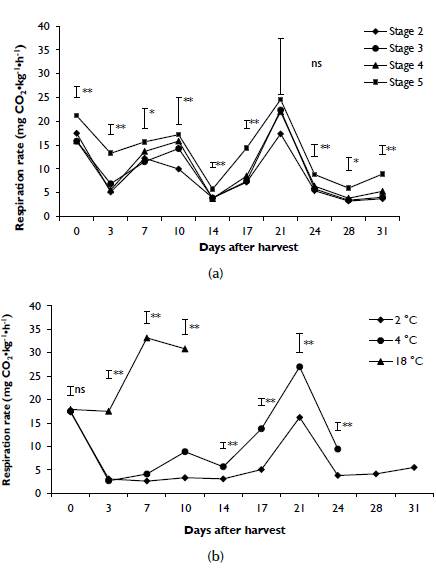
Note: The vertical bars indicate the minimum significant difference according to the Tukey test (p ≤ 0,05). *statistical differences at 5%, **statistical difference at 1%, ns: no differences. Source: Authors
Figure 3 Effect of a) the maturity stage and b) storage temperatures on the respiration rate (RR) of plum fruits during postharvest.
By analyzing the storage temperature factor, it was clear that the fruits stored at 18 °C had the highest value when compared to the values obtained in the fruits stored at 2 and 4 °C (Figure 3b). At 10 dah, the biggest difference was observed, with values of 3,31, 8,87, and 30,83 mg CO2 kg-1h-1 for fruits stored at 2, 4 and 18°C, respectively. Similarly, a decrease in RR was only observed in the fruits stored at room temperature (18 °C), indicating that, at this sampling point (10 dah), the senescence of fruits and loss of consumption quality began, so this treatment was discontinued.
In this regard, Kader (2002) classified plum fruits as having a moderate RR (10 to 20 mg CO2kg-1h-1), but a high production of ethylene, which accelerates the metabolic processes that induce maturation. Similarly, Iqbal et al. (2009) stated that RR increases at high temperatures, in all combinations of concentrations of O2 and CO2. Therefore, temperatures of 18 °C, to which the plums were subjected, increased the RR. This shortened the product's shelf-life, considering that respiration causes oxidative degradation of materials such as starch, sugars, and organic acids due to energy production and other molecules used in synthesis reactions (Saltveit, 2019). The fruits stored at 15,6 0C had more intense respiration than the fruits stored at 0 0C, which only released at 10% to 20% of the heat of respiration when stored at 15,6 0C, allowing to preserve the fruits for longer periods of time, as indeed occurred in this study; the fruits stored at 2 0C managed to preserve their commercial quality for 31 days.
The results of this study are consistent with those reported by Parra et al. (2008), where the RR of the 'Horvin' plum showed the typical behavior of a climacteric product due to its continuous increase in the RR, reaching the highest level with the climacteric peak and then decreasing with senescence, which occurred at 31 days with fruits that had a RR of 22,02 mg CO2-kg-1-h-1. Likewise, these results match those reported by Sharma and Sharma (2016), who found that ethylene absorbers decreased the respiration of plum fruits of the Santa Rosa variety. However, the fruits reached climacteric peaks of up to 54 mg CO2kg 1 h-1.
Conclusions
The fruits in maturity stage 5 had higher pH, TSS, CI, MI, and RR values, but they also had a greater loss of firmness. The most suitable refrigeration temperature for the 'Horvin' plum fruits was 2 0 C, at which they maintained consumption quality for longer (31 days). Refrigeration decreased the loss of TTA during postharvest. The fruits in maturity stage 5 had higher pH, TSS, CI, MI, and RR values, but they also had greater loss of firmness. The highest RR for fruit stored at 2 and 4 0C occurred after 21 days of cold-storage. The fruits without refrigeration only maintained the quality of consumption for 10 dah.
















